Papers by Aurélia Souares
Santé Publique, 2006
Connaissances et pratiques des agents de santé de la région de Thiès concernant la nouvelle théra... more Connaissances et pratiques des agents de santé de la région de Thiès concernant la nouvelle thérapie des accès palustres par A. SOUARES, R. LALOU, I. SENE, D. SOW et J.-Y. LE HESRAN | Société française de santé publique | Santé publique 2006/2 -N° 18 ISSN 0995-3914 | pages 299 à 310 Pour citer cet article : -Souares A., Lalou R., Sene I., Sow D. et Le Hesran J.-Y., Connaissances et pratiques des agents de santé de la région de Thiès concernant la nouvelle thérapie des accès palustres, Santé publique 2006/2, N° 18, p. 299-310.

Global Health Action, 2015
Micro health insurance schemes have been implemented across developing countries as a means of fa... more Micro health insurance schemes have been implemented across developing countries as a means of facilitating access to modern medical care, with the ultimate aim of improving health. This effect, however, has not been explored sufficiently. We investigated the effect of enrolment into community-based health insurance on mortality in children under 5 years of age in a health and demographic surveillance system in Nouna, Burkina Faso. We analysed the effect of health insurance enrolment on child mortality with a Cox regression model. We adjusted for variables that we found to be related to the enrolment in health insurance in a preceding analysis. Based on the analysis of 33,500 children, the risk of mortality was 46% lower in children enrolled in health insurance as compared to the non-enrolled children (HR=0.54, 95% CI 0.43-0.68) after adjustment for possible confounders. We identified socioeconomic status, father's education, distance to the health facility, year of birth, and insurance status of the mother at time of birth as the major determinants of health insurance enrolment. The strong effect of health insurance enrolment on child mortality may be explained by increased utilisation of health services by enrolled children; however, other non-observed factors cannot be excluded. Because malaria is a main cause of death in the study area, early consultation of health services in case of infection could prevent many deaths. Concerning the magnitude of the effect, implementation of health insurance could be a major driving factor of reduction in child mortality in the developing world.
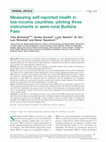
Global Health Action, 2012
Background: National surveys in low-income countries increasingly rely on self-reported measures ... more Background: National surveys in low-income countries increasingly rely on self-reported measures of health. The ease, speed, and economy of collecting self-reports of health make such collection attractive for rapid appraisals. However, the interpretation of these measures is complicated since different cultures understand and respond to the same question in different ways. Objective: The aim of this pilot study was to develop a culturally sensitive tool to study the self-reported health (SRH) of the local adult population in Burkina Faso. Design: The study was carried out in the 2009 rainy season. The sample included 27 men and 25 women aged 18 or older who live in semi-urban Nouna, Burkina Faso. Three culturally adapted instruments were tested: a SRH question, a wooden visual analogue scale (VAS), and a drawn VAS. Respondents were asked to explain their answers to each instrument. The narratives were analyzed with the content analysis technique, and the prevalence of poor SRH was estimated from the quantitative data by stratification for respondent background variables (sex, age, literacy, education, marital status, ethnicity, chronic diseases). The correlation between the instruments was tested with Spearman's correlation test. Results: The SRH question showed a 38.5% prevalence of poor SRH and 44.2% prevalence with both VAS. The correlation between the VAS was 0.89, whereas the correlation between the VAS and the SRH question was 0.60Á0.64. Nevertheless, the question used as the basis of each instrument was culturally sensitive and clear to all respondents. Analysis of the narratives shows that respondents clearly differentiated between the various health statuses. Conclusion: In this pilot, we developed and tested a new version of the SRH question that may be more culturally sensitive than its non-adapted equivalents. Additional insight into this population's understanding and reporting of health was also obtained. A larger sample is needed to further study the validity and reliability of the SRH question and the VAS and understand which instrument is best suited to study SRH in the low-income setting of semi-rural Burkina Faso.

Social science & medicine (1982), 2014
In a community-based health insurance (CBHI) introduced in 2004 in Nouna health district, Burkina... more In a community-based health insurance (CBHI) introduced in 2004 in Nouna health district, Burkina Faso, poor perceived quality of care by CBHI enrollees has been a key factor in observed high drop-out rates. The poor quality perceptions have been previously attributed to health worker dissatisfaction with the provider payment method used by the scheme and the resulting financial risk of health centers. This study applied a mixed-methods approach to investigate how health workers working in facilities contracted by the CBHI view the methods of provider payment used by the CBHI. In order to analyze these relationships, we conducted 23 in-depth interviews and a quantitative survey with 98 health workers working in the CBHI intervention zone. The qualitative in-depth interviews identified that insufficient levels of capitation payments, the infrequent schedule of capitation payment, and lack of a payment mechanism for reimbursing service fees were perceived as significant sources of hea...

Transactions of the Royal Society of Tropical Medicine and Hygiene, 2014
This study aimed to investigate the relationship between household wealth and under-5 year mortal... more This study aimed to investigate the relationship between household wealth and under-5 year mortality in rural and semi-urban Burkina Faso. The study included 15 543 children born between 2005 and 2010 in the Nouna Health and Demographic Surveillance System. Information on household wealth was collected in 2009. Two separate wealth indicators were calculated by principal components analysis for the rural and the semi-urban households, which were then divided into quintiles accordingly. Multivariable Cox proportional hazards regression was used to study the effect of the respective wealth measure on under-5 mortality. We observed 1201 childhood deaths, corresponding to 5-year survival probability of 93.6% and 88% in the semi-urban and rural area, respectively. In the semi-urban area, household wealth was significantly related to under-5 mortality after adjustment for confounding. There was a similar but non-significant effect of household wealth on infant mortality, too. There was no ...
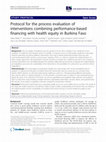
Implementation Science, 2014
The low quality of healthcare and the presence of user fees in Burkina Faso contribute to low uti... more The low quality of healthcare and the presence of user fees in Burkina Faso contribute to low utilization of healthcare and elevated levels of mortality. To improve access to high-quality healthcare and equity, national authorities are testing different intervention arms that combine performance-based financing with community-based health insurance and pro-poor targeting. There is a need to evaluate the implementation of these unique approaches. We developed a research protocol to analyze the conditions that led to the emergence of these intervention arms, the fidelity between the activities initially planned and those conducted, the implementation and adaptation processes, the sustainability of the interventions, the possibilities for scaling them up, and their ethical implications. Methods/Design: The study adopts a longitudinal multiple case study design with several embedded levels of analyses. To represent the diversity of contexts where the intervention arms are carried out, we will select three districts. Within districts, we will select both primary healthcare centers (n =18) representing different intervention arms and the district or regional hospital (n =3). We will select contrasted cases in relation to their initial performance (good, fair, poor). Over a period of 18 months, we will use quantitative and qualitative data collection and analytical tools to study these cases including in-depth interviews, participatory observation, research diaries, and questionnaires. We will give more weight to qualitative methods compared to quantitative methods.
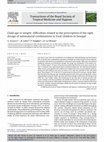
Transactions of the Royal Society of Tropical Medicine and Hygiene, 2010
Less than a year after the introduction of amodiaquine (AQ)/sulfadoxine-pyrimethamine (SP) as the... more Less than a year after the introduction of amodiaquine (AQ)/sulfadoxine-pyrimethamine (SP) as the first-line antimalarial treatment in Senegal, our study aimed to assess patients' drug intake and check its correspondence with nurses' prescription-adherence, the national guidelines regimen and theoretical dosage. The study was conducted at five health centers. Children aged 2-10 years who were prescribed AQ/SP by the nurse were recruited. At day 3, caregivers were questioned about treatment adherence. We collected information about nurses' prescriptions and conducted in-depth interviews on prescription patterns. Among the 289 children who were recruited, 35.3% took less than 80% of the prescribed doses. Nevertheless, 47.7% and 83.7% respectively for AQ and SP received a dosage higher than the theoretical dosage. Age-weight discrepancy leads to overprescribing drugs: nurses acknowledged using the child's age more often than weight to determine the dosage if the child has a low weight. Under and overdosing are not only due to patient practices but causes related to national guidelines and health staff practices. For successful implementation and utilization of antimalarial combinations in Africa, countries should really focus on nurses' training. National guidelines should also be based on national average weight instead of international tables.

Transactions of the Royal Society of Tropical Medicine and Hygiene, 2008
Increased Plasmodium falciparum resistance to chloroquine has prompted national malaria programs ... more Increased Plasmodium falciparum resistance to chloroquine has prompted national malaria programs to develop new policies in several African countries. Less than a year after the introduction of amodiaquine/sulfadoxine-pyrimethamine (AQ/SP) as first-line treatment in Senegal, we examined adherence rates to therapy and its efficacy among children. The study was conducted in five dispensaries in rural Senegal. Children aged 2-10 years with a presumptive diagnosis of malaria were prescribed AQ/SP. Thick blood film analyses were carried out on days 0, 3, 7, 14 and 28. Blood and urine samples were collected on day 3 for drug level measurements. The principal caregivers were questioned on treatment adherence. Among the 289 recruited children, 144 had a parasitemia >2500/l. The results demonstrated markedly good efficacy for the treatment, as no detectable parasitemia was observed on day 28 for 97.9% of the children. However, we noticed that 35.3% of children did not comply with the recommended doses and 62.3% did not exactly adhere to the drug schedule. Despite the good efficacy of the drugs, adherence to the therapeutic scheme was poor. Strategies to promote patient adherence would improve drug performance and thus might help to prevent the rapid emergence of drug resistance.
Malaria Journal, 2009
The introduction of new anti-malarial treatment that is effective, but more expensive, raises que... more The introduction of new anti-malarial treatment that is effective, but more expensive, raises questions about whether the high level of effectiveness observed in clinical trials can be found in a context of family use. The objective of this study was to determine the factors related to adherence, when using the amodiaquine/sulphadoxine-pyrimethamine (AQ/SP) association, a transitory strategy before ACT implementation in Senegal.
Malaria Journal, 2009
Background: Although there are many methods available for measuring compliance, there is no forma... more Background: Although there are many methods available for measuring compliance, there is no formal gold standard. Different techniques used to measure compliance were compared among children treated by the anti-malarial amodiaquine/sulphadoxine-pyrimethamine (AQ/SP) combination therapy, in use in Senegal between 2004 and 2006.

Journal of Tropical Pediatrics, 2010
Knowledge and practices with respect to malaria are aspects that need to be considered as part of... more Knowledge and practices with respect to malaria are aspects that need to be considered as part of effective malaria programs. We assessed and compared malaria practices and knowledge among those who had recently visited a health care provider and those who had not. A matched, population-based case-control study was conducted among 338 women between 15 and 45 years of age and caretakers of children ≤ 9 years of age in Nouna, Burkina Faso. Little difference was found in the reported responses between the cases and controls, which indicates that recent visits to health care providers may not have an effect on malaria risk or knowledge. Differences were noted in malaria practices, which could suggest that health care providers are consulted only after home treatments fail. Therefore, programs and policies targeted to health care providers aimed at improving the dissemination of information may be of some benefit.

The International Journal of Health Planning and Management, 2013
Some developing countries have incorporated managed care elements into their national health insu... more Some developing countries have incorporated managed care elements into their national health insurance schemes. In practice, hybrid health management organizations (Hmos) are insurers who, bearing some resemblance to managed care in the USA, are vertically integrated in the scheme's revenue collection and pool and purchase healthcare services within a competitive framework. To date, few studies have focused on these organizations and their level of satisfaction with the scheme's optimal-resource-use (ORU) implementation. In Nigeria, the study site, Hmos were categorized on the basis of their satisfaction with ORU activities. One hundred forty-seven Hmo staff were randomly interviewed. The types of ORU domain categories were provider payment mechanism, administrative efficiency, benefit package inclusions and active monitoring mechanism. Bivariate analysis was used to determine differences among the Hmos' satisfaction with the various ORU domains. The Hmos' satisfaction with the health insurance scheme's ORU activities was 59.2% generally, and the associated factors were identified. According to the Hmos' perspectives related to the type of ORU, the fee-for-service payment method and regular inspection performed weakly. Hmos' limited satisfaction with the scheme's ORU raises concerns regarding ineffectiveness that may hinder implementation. To offset high risks in the scheme, it appears necessary for the regulatory agency to adapt and reform strategies of provider payment and active monitoring mechanisms according to stakeholder needs. Our findings further reveal that having Hmos evaluate ORU is useful for providing evidence-based information for policy making and regulatory utilization related to implementation of the health insurance scheme.
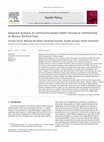
Health Policy, 2009
Objectives: This study aims to identify the reasons why enrolled people decide not to renew their... more Objectives: This study aims to identify the reasons why enrolled people decide not to renew their membership in following years. Methods: Household survey is used to collect information on the factors influencing dropping out from community-based health insurance (CBI). Information from CBI agency databank is used to describe the general situation of enrolment and drop-out. Results: Since the launch of CBI the enrolment rate has been low ranging from 5.2% to 6.3%. The drop-out rate, however, has been high ranging from 30.9% to 45.7%. It is found, by the multivariate analysis, that female household head, higher age or lower education of a household head, lower number of illness episodes in the past three months, fewer children or elderly in a household, poor perceived health care quality, less seeking care in the past month positively effected on drop-out, increasing the rate. However, the household six-month expenditure and the distance to the contracted health facility did not have the hypothesised sign. In contrast, a higher household expenditure and a shorter distance to the contracted health facility increased the drop-out. Conclusions: High drop-out rates endanger the sustainability of CBI not only because they reduce the size of the insurance pool, but also because they bear a negative impact on further enrolment and drop-out. The drop-out rate in the scheme of the Nouna Health District, Burkina Faso, is very high. The reasons for drop-out may be related to affordability, healthneeds and health demand, quality of care, household head and household characteristics. This study represents a valuable attempt towards further increasing the sustainability of CBI schemes, by understanding not what motivates people to first enrol in CBI, but what motivates them to renew membership year after year.
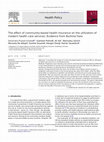
Health Policy, 2009
Objective: To quantify the impact of community-based health insurance (CBI) on utilization of hea... more Objective: To quantify the impact of community-based health insurance (CBI) on utilization of health care services in rural Burkina Faso. Methods: Propensity score matching was used to minimise the observed baseline differences in the characteristics of insured and uninsured groups such that the observed difference in healthcare utilisation could generally be attributed to the CBI. Results: Compared with those who were not enrolled in the CBI, the overall increase in outpatient visits given illness in the insured group was about 40% higher, while the differential effect on utilization of inpatient care between insured and non-insured groups was insignificant. Not only were the very poor less likely to enroll in CBI, but even once insured, they were less likely to utilize health services compared to their wealthier counterparts. Conclusions: The overall effect of CBI on health care utilization is significant and positive but the benefit of CBI is not equally enjoyed by all socioeconomic groups. The policy implications are: (a) there is a need to subsidize the premium to favor the enrolment of the very poor; and (b) various measures need to be placed in order to maximize the population's capacity to enjoy the benefits of insurance once insured. (D.P. Gnawali). is relatively new in terms of its implementation and there is a clear lack of empirical evidence to judge its performance . Several studies suggest that CBI is likely to increase the utilization [4] and some of them have quantified the effect [5] but very few have assessed the utilization effect by identifying all sources of potential biases and minimizing them . This paucity of evidence is overwhelming as policy makers and health planners need empirical data to justify whether investing in CBI provides any value for money and ensures equitable access to health care services to the rural people .

Health & Social Care in the Community, 2010
Access to health-care is low in developing countries. Poor people are less likely to seek care th... more Access to health-care is low in developing countries. Poor people are less likely to seek care than those who are better off. Community-based health insurance (CBI) aims to improve healthcare utilisation by removing financial barriers, unfortunately CBI has been less effective in securing equity than expected. Poor people, who probably require greater protection from catastrophic health expenses, are less likely to enrol in such schemes. Therefore, it is important to implement targeted interventions so that the most in need are not left out. CBI has been offered to a district in Burkina Faso, comprising 7762 households in 41 villages and the district capital of Nouna since 2004. Community wealth ranking (CWR) was used in 2007 to identify the poorest quintile of households who were subsequently offered insurance at half the usual premium rate. The CWR is easy to implement and requires minimal resources such as interviews with local informants. As used in this study, the agreement between the key informants was more (37.5%) in the villages than in Nouna town (27.3%). CBI management unit only received nine complaints from villagers who considered that some households had been wrongly identified. Among the poorest, the annual enrolment increased from 18 households (1.1%) in 2006 to 186 (11.1%) in 2007 after subsidies. CWR is an alternative methodology to identify poor households and was found to be more cost and time efficient compared to other methods. It could be successfully replicated in low-income countries with similar contexts. Moreover, targeted subsidies had a positive impact on enrolment.
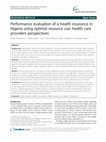
Background: Performance measures are often neglected during the transition period of national hea... more Background: Performance measures are often neglected during the transition period of national health insurance scheme implementation in many low and middle income countries. These measurements evaluate the extent to which various aspects of the schemes meet their key objectives. This study assesses the implementation of a health insurance scheme using optimal resource use domains and examines possible factors that influence each domain, according to providers' perspectives. Methods: A retrospective, cross-sectional survey was done between August and December 2010 in Kaduna state, and 466 health care provider personnel were interviewed. Optimal-resource-use was defined in four domains: provider payment mechanism (capitation and fee-for-service payment methods), benefit package, administrative efficiency, and active monitoring mechanism. Logistic regression analysis was used to identify provider factors that may influence each domain. Results: In the provider payment mechanism domain, capitation payment method (95%) performed better than fee-for-service payment method (62%). Benefit package domain performed strongly (97%), while active monitoring mechanism performed weakly (37%). In the administrative efficiency domain, both promptness of referral system (80%) and prompt arrival of funds (93%) performed well. At the individual level, providers with fewer enrolees encountered difficulties with reimbursement. Other factors significantly influenced each of the optimal-resource-use domains. Conclusions: Fee-for-service payment method and claims review, in the provider payment and active monitoring mechanisms, respectively, performed weakly according to the providers' (at individual-level) perspectives. A short-fall on the supply-side of health insurance could lead to a direct or indirect adverse effect on the demand-side of the scheme. Capitation payment per enrolees should be revised to conform to economic circumstances. Performance indicators and providers' characteristics and experiences associated with resource use can assist policy makers to monitor and evaluate health insurance implementation.
BMC Health Services Research, 2012
Background: Although most community-based health insurance (CBHI) schemes are voluntary, problem ... more Background: Although most community-based health insurance (CBHI) schemes are voluntary, problem of adverse selection is hardly studied. Evidence on the impact of targeted subsidies on adverse selection is completely missing. This paper investigates adverse selection in a CBHI scheme in Burkina Faso. First, we studied the change in adverse selection over a period of 4 years. Second, we studied the effect of targeted subsidies on adverse selection.
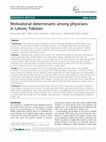
BMC Health Services Research, 2010
Introduction: Human resource crises in developing countries have been identified as a critical as... more Introduction: Human resource crises in developing countries have been identified as a critical aspect of poor quality and low accessibility in health care. Worker motivation is an important facet of this issue. Specifically, motivation among physicians, who are an important bridge between health systems and patients, should be considered. This study aimed to identify the determinants of job motivation among physicians, a neglected perspective, especially in developing countries. Methods: A stratified random sample of 360 physicians was selected from public primary, public secondary and public and private tertiary health facilities in the Lahore district, Pakistan. Pretested, semi-structured, selfadministered questionnaires were used. For the descriptive part of this study, physicians were asked to report their 5 most important work motivators and demotivators within the context of their current jobs and in general. Responses were coded according to emergent themes and frequencies calculated. Of the 30 factors identified, 10 were classified as intrinsic, 16 as organizational and 4 as socio-cultural. Results: Intrinsic and socio-cultural factors like serving people, respect and career growth were important motivators. Conversely, demotivators across setups were mostly organizational, especially in current jobs. Among these, less pay was reported the most frequently. Fewer opportunities for higher qualifications was a demotivator among primary and secondary physicians. Less personal safety and poor working conditions were important in the public sector, particularly among female physicians. Among private tertiary physicians financial incentives other than pay and good working conditions were motivators in current jobs. Socio-cultural and intrinsic factors like less personal and social time and the inability to financially support oneself and family were more important among male physicians. Conclusion: Motivational determinants differed across different levels of care, sectors and genders. Nonetheless, the important motivators across setups in this study were mostly intrinsic and socio-cultural, which are difficult to affect while the demotivators were largely organizational. Many can be addressed even at the facility level such as less personal safety and poor working conditions. Thus, in resource limited settings a good strategic starting point could be small scale changes that may markedly improve physicians' motivation and subsequently the quality of health care.
BMC Health Services Research, 2013
Background: Responsiveness of health care services in low and middle income countries has been gi... more Background: Responsiveness of health care services in low and middle income countries has been given little attention. Despite being introduced over a decade ago in many developing countries, national health insurance schemes have yet to be evaluated in terms of responsiveness of health care services. Although this responsiveness has been evaluated in many developed countries, it has rarely been done in developing countries. The concept of responsiveness is multi-dimensional and can be measured across various domains including prompt attention, dignity, communication, autonomy, choice of provider, quality of facilities, confidentiality and access to family support. This study examines the insured users' perspectives of their health care services' responsiveness.

Uploads
Papers by Aurélia Souares